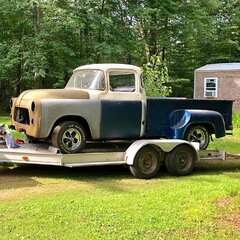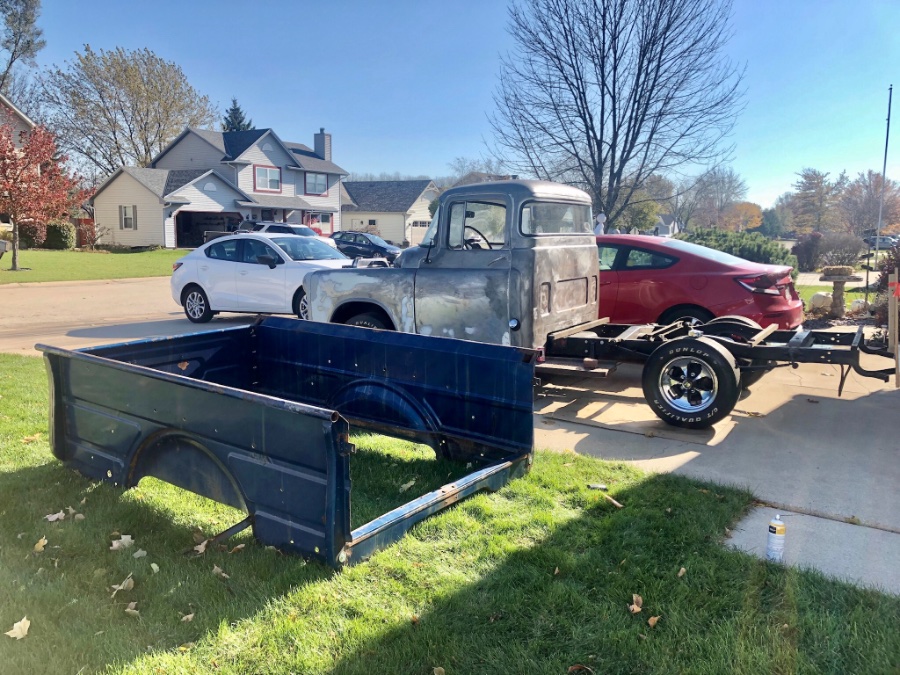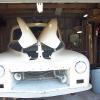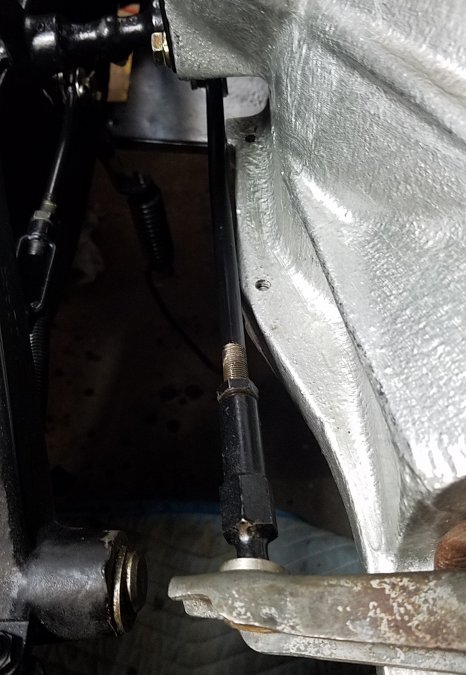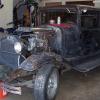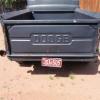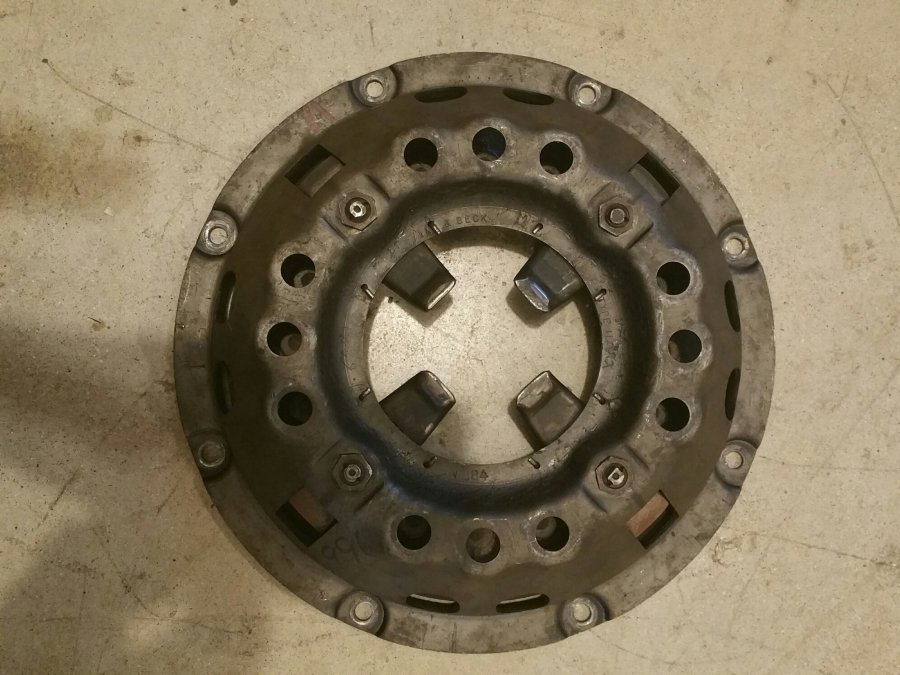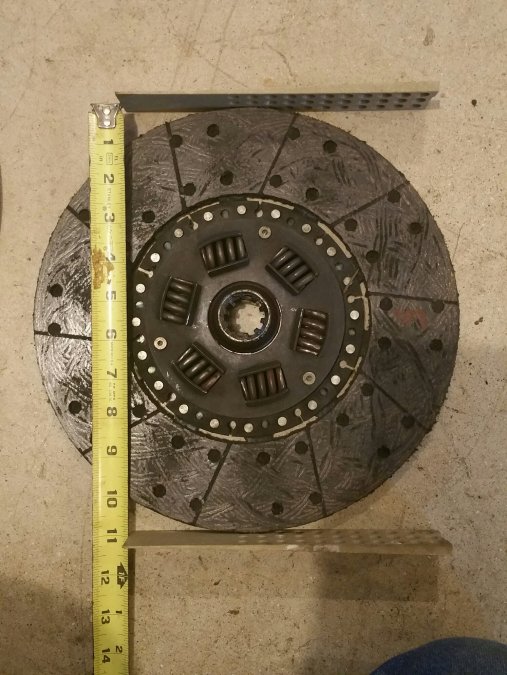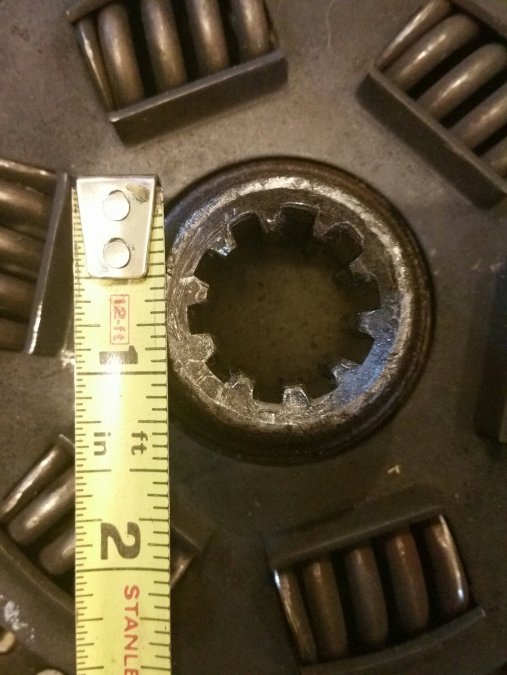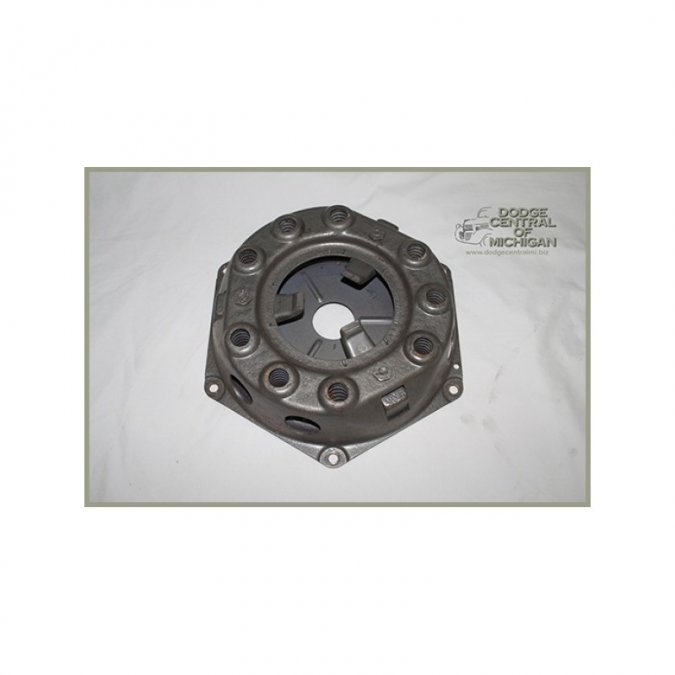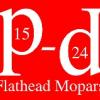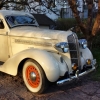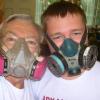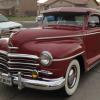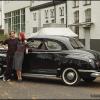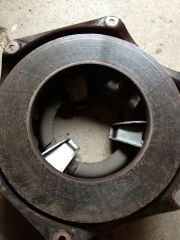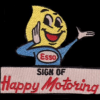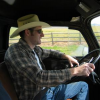Search the Community
Showing results for tags 'clutch'.
-
Hello! My name is Kristina. I’ve been lurking here a bit and finally decided to jump in and ask a question or two. My dad and I have been restoring a 1953 Plymouth Cambridge together for fun, but neither of us are what you’d call a car person. I’m pretty mechanically inclined (I’ve spent the majority of my career fixing computers), and good at problem-solving though so we’ve been making progress. Slow progress, but progress. I’ve spent a lot of time researching answers to our questions, and this forum has ended up helping a lot. However, now we’ve run up against a problem that requires more than I can just Google. well, two problems, really, and I think they’re connected. We cannot get the clutch to engage and we can’t bleed the front brakes. The backs are fine. The reason I believe these two issues are connected is that we had to remove the floor panel and replace the master cylinder. Now because the back brakes bleed and engage, we know that it’s not the cylinder itself but rather a mistake we made while reassembling the whole area (especially the clutch, bc we tested that before replacing the cylinder and the car went into gear and the wheels spun.). I *think* that the problem with the clutch is improper adjustment of the push rod that engages the transmission when the clutch is pressed, but I’m really not sure. I have a manual from the 1930s-40s, but obviously it’s the wrong decade. We ordered the correct one today. We also had to remove...I’m sorry, I don’t know what it’s called, I’m pretty bad with correct terminology...anyway, we had to remove the drivers side metal brake line that runs from this little connector/splitter thing and up to the drivers side front brake and reinstall it in order to replace the rubber hose that connects it to the brake itself. We managed to twist off the end of the metal tube in the course of removing the old cylinders, but we repaired it with the proper equipment. I don’t think it’s this though because both front brakes are the problem, not just that one. All of the shoes and cylinders were replaced with new ones as well. I'm not sure what other info or pictures would be relevant but I can get them if requested. So do you guys have any ideas? Especially ones that don’t involve taking off the foot well panel and the brake/gas/clutch assembly again because MAN was that a pain in the rear to get back on. Thanks for any help you can provide!
- 12 replies
-
I cleaned and reinstalled my clutch on my '55 C3 B8. Today, I adjusted the clutch linkage via the turn buckle, plenty of threads each way. However, the column shift doesn't want to go into gear (even 2nd) while engine is running and the pedal feels fairly light (or soft), like I can press down all the way to the floor with my hand. How heavy (or light) is this clutch supposed to feel? I have a feeling the pressure plate might be shot. I could see the throwout bearing engage with the pressure plate springs (four of them on my model), so there is some articulation there. On a side note, I got the box mocked back up and set on the frame today. Friday, I rewired the negative from coil to distributor, as points weren't firing. It's always something... Any insight on the clutch is appreciated, thanks! Havs
- 1 reply
-
- clutch
- clutch disc
-
(and 3 more)
Tagged with:
-
I am a novice trying to reinstall the 4 speed transmission in my 1952 B-C-3. I followed the directions in the manual when removing the transmission and slid it out on guide pins placed in the upper bolt holes. Now when I try and slide it back in it is getting hung up. It appears to me that the throw out bearing is the issue. I can't seem to get it lined up up correctly. I tried putting the bearing directly on the transmission shaft but then I can't get it past the clutch fork. I then tried to remove the clutch fork but can't seem to get it out of the housing with the clutch installed. Can someone please advise what the correct procedure for installing the transmission? The book just says "reverse removal procedure". Thank you!!!
- 32 replies
-
- transmission
- clutch
-
(and 2 more)
Tagged with:
-
Today I installed the clutch linkage. New clevis pins were in order as originals were badly grooved. Found close to stock size. Slightly larger required washers to keep rods from sliding side to side. I need advice on the position of the rod and turnbuckle. The rod seems too close to the bell housing. Is this correct? Also, do I have the offsets on the turnbuckle installed correctly on the pins? Wasn't sure how these angled offsets were supposed to face. Thanks for and help or photos!
-
Hey there....just got done replacing clutch disc and pressure plate after driving my 1940 Plymouth pickup for about 40 years....flywheel was not turned, didn’t need it....parts were built by a reputable nationally known shop. Now that everything is back together, T/O bearing won’t reach the pressure plate fingers until pedal is almost to the floor, even with the adjustment screws on the ears all the way out/in on their respective sides. It is an 11” clutch, and was wondering if there was a different style throwout bearing sleeve for the 11” setup that I am not aware of??. I need for the bearing to be another inch or so closer to the clutch in order to operate, and was wondering if there was a sleeve that didn’t have such a deep recess to the flat “lands” that the fork levers ride on when they push the bearing into the clutch. It is strange, because nothing has changed in the setup since the parts were sent off. I am in Missouri, rebuilder is in Massachusetts, and I could use some input before I start fabricating a solution. Thank you in advance....
- 4 replies
-
- clutch
- adjustment
-
(and 1 more)
Tagged with:
-
Question please for you P15 members out there. My project car didn't have the correct clutch return fork spring setup when we got it. It had been southern engineered to work. It was missing the little pointed (arrow head looking on both ends) bracket that attaches to the bell housing, ( that the return spring anchors to ), and seems like they had a spring connected over to one of the pins on the torque shaft (If I remember correctly). Since then, a forum member sent me a tracing of the anchor brkt, which has been made and attached to the car. So know I was trying to identify and locate a Clutch return Spring. The book calls for a part # 626220, and the exploded diagram I have in my parts book shows the pic you see attached below. (A spring that looks to have a long straight hook end that reaches out on one side where it connects to the anchor brkt)... I've also found a picture of what is supposed to be an original mopar 626220 spring, which is also attached to the post. as you can see this spring doesn't have the long reaching straight section on one side, just looks more like a conventional spring, (looks much like the spring on the overcenter spring assy used on these cars). When I physically eyeball the distance from the clutch return fork, to the anchor point on the anchor brkt, it only looks to be about 6 inches or so, so I'm thinking I must be reading something into the parts book drawing that is not actually true. If any of you P15 owners could help identify, confirm what an actual 626220 Clutch return fork spring looks like, it would help. Thanks again Steve
-
I'm wondering why the clutch that came with my 1951 B3B doesn't look like the clutch on page 163 of the shop manual. Here's what came with my truck: (I included two pictures of my clutch disc just to help with an ID. The disc is 11 inches wide. The center hub has 10 splines and looks like 1 1/4 inches in diameter.) The clutch shown in the shop manual (page 163) looks more like the one in the picture below (which I copied from the DCM Central web site. Can anyone explain the apparent discrepancies between my clutch and the ones pictured in the shop manual and at DCM? 1. My clutch cover is round. The one below from DCM (and also in the book) has a hexagonal shape. 2. My clutch cover has 4 release levers. The one below (and also in the shop manual) has only 3.
- 3 replies
-
- pressure plate
- clutch disc
-
(and 1 more)
Tagged with:
-
First off, forgive me that I'm new to all this. I'm learning as I go. Had a bad clutch chatter in my '47 Plymouth and am replacing the rear main seals and clutch. I ordered a new clutch disc from Bernbaum but the new one has a deeper offset than my original and doesn't seat properly in the pressure plate. I looked on the forums and for other online images and haven't found another that looks similiar to the one that I have. I am wondering if I just need to order another pressure plate or find a different clutch. The clutch that came out is a 9 1/4. Also, I was wondering if anyone could tell me if there is any sort of plug or cap that is supposed to go on the transmission where it bolts up. I got a new seal and it has a hole around the opening and it seems to me like there should be, but again, I have zero experience and the manual doesn't show anything. Thanks! Dan
- 23 replies
-
- pressure plate
- clutch
-
(and 4 more)
Tagged with:
-
As an owner of a B1 truck with an original 4 speed crash box (aka non syncro tranny with compound low) one story you hear is you can shift without using the clutch. Having learned to double clutch to avoid the "grind them till you find them" syndrome of shifting I have to say I was always intrigued by the myth of clutchless shifting. For our owners who always lived in the world of fully synchronized transmissions, double clutching is the technique used to shift a transmissions with "straight cut gears' or no synchronizers. Internally the transmission is pretty simple and very reliable in service. To double clutch you use the clutch normally to get rolling and when you are ready to to shift your depress and release the clutch once to take it out one gear and a second time to go into another the next gear. The process basically slows down the shift so the gear speeds match and allow them to slide into the next gear. Downshifting is similar except you have to remember to bring up the engine revs as you go into the lower gear. But what about clutchless shifts? Well, as professional OTR drivers know it is not a myth but a useful technique to drive your truck with less wear and tear on the clutch. Success is all about getting the engine speed right and feeling the gears as you slide them in the gearbox. Again use the clutch normally to get rolling. As you near the shift point lift off the gas slightly and slide the shifter into the gate for the next gear. As the speeds match the shift will smoothly drop into the next gear with no grinding and no clutch needed! Don't be frustrated if the first few times you miss and grind the gears. With a little practice you will be able to tell with engine speed and feeling it in the shift lever when it is time to shift. Downshifting is also possible but requires a little more finesse with engine speed and shift lever. Remember since your are going down in gears you need to raise engine rpm to match the the gear when you downshift. So instead of a slight lift off on the throttle you need to give it a little bump up. Again with the gear speed and engine speed match you can fell it in the gearshift lever as it will easily slide into gear without a grind. And what about the compound low (AKA, granny gear)? It's function is to help you get moving when you have a big load on board. A while back I had half a yard of sand loaded in the bed. When I started to pull out of the loading area in first it was immediately evident I would have to slip the clutch quite a bit to get rolling. Dropping into compound low we just pulled out like a normal start, just slower. Once we got past the the initial start up resistance from a dead stop it was easy to drive. Have any of you mastered the art of clutchless shifts?
-
Hello All, I am in need of some advice. I'm currently attempting to replace the clutch in my 1946 Plymouth Deluxe Club Coupe. I have disconnected the drive shaft and transmission, but can't figure out the best way to access the clutch and flywheel. My shop manual doesn't get into very much detail here at all, and I'm stumped. The bell housing seems to bolt on top of a frame crossmember. So, what is the best next step in removing this? Is there an easiest way to remove the clutch linkages from the bell housing? (That is, should I just disconnect them from the clutch petal, or from the bell housing?) Does the clutch plate put pressure on the bell housing (that is, will it spring off when I take out the bolts)? Should I remove the flywheel cover? Is the engine supported directly by this bell housing (since it's bolted to the frame)? If so, how should I support the engine while making this repair? Many Thanks in Advance, and Best, J.P.G.
- 39 replies
-
Please forgive my ignorance.... I'm learning as I go. Replaced the clutch and throw-out bearing in my '47 Plymouth. Put the linkage back together (at least I thought I did) and now the clutch pedal practically falls down. With the last inch or so of movement, it will engage the clutch. I took of the rod going to the fork and the small return spring and that was it. The pressure plate is the same, I didn't take off the pivot, the clutch arm and over center spring weren't touched. Nothing regarding the adjustment should be different and I've taken the clutch pan back off twice to check that my fork is attached to the bearing and that the pivot is in place. I have no pride left and I'm hoping it's something simple that I'm overlooking or doing wrong.
-
I got the transmission into place (the engine has been in the car all the time) and I was really happy. However, I noticed that the clutch for was not in place. It didn't hang on the fork pivot and not in the right position with the bearing. It was just hanging there lose :-( I tried to get into the position, but it seems to be impossible. I don't want to use too much power. I am not looking forward to resemble the transition. It was a hard work to get it there! Has someone the same experience and having some good advice how to solve it? It's a Dodge from -36 and the transmission is a R10 from -53 so it's really tight and the r10 is quite heavy especially trying to lift in in position from below.
-
Hey follow members, I have a delima. I replaced the entire clutch, pressure plate and throw out bearing on my fluid drive 1949 Wayfarer business mans coupe. Now I have a vibration. I read in the book that upon removing the assembly to mark it with the bell housing. If you replace it all how would you know how to bolt it up sense the parts are all new? I know the motor is internally balanced so it can't be that. The old parts are gone unfortunetly. Please help if any one has any ideas. Thanks Terry Hancock
-
Is there a good aftermarket clutch and pressure plate for the Dodge PU 1949 B1B? This is 10" Dia. 10 spline clutch. I have seen plenty of "Precision Clutch" advertisements but no way to search for compatibility with my truck.
-
Good evening, 1948 Plymouth Coupe Original. Need help. I am having problems going into 1st and Reverse. Here is how it all started. Lowered the car in the back and in the front. Rear blocks 3inch (car no problem) Cut the front Springs. All started after I did the front. I don't know if that is what started the problem. After lowering the car in the front I noticed that my Transmission mounts were really bad. So bad you could not see the rubber. GONE. at the time It was really hard to get into 2nd and 3rd. Then it changed from only going into Reverse, 1st and 3rd. I thought maybe the Transmission was moved or something that was causing the problem. After installing the transmission mounts I tough that would fix the problem, well I can't go into 1st or Reverse. Any Ideas? Please help. Thanks, Ariel
-
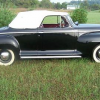
ANSWERED Back, Clutch & Pressure Plates, A Whole Lotta Shakin'
JohnTeee posted a topic in P15-D24 Forum
Well, after a long hiatus, both from the forum and the '47 Plymouth, we are getting things going again. We 'blew up' a clutch a while back and experienced a some problems trying to replace it. Not sure if I brought the first set of problems on to myself . . . In looking at the flywheel, there are two sets of bolt holes: the 'inner' set matches up to my original Borg & Beck 9-1/8" Clutch and Pressure Plate, rebuilt by TN Clutch in 2005. The 'outer' set of holes match up to the 10" 6-Spring Borg & Beck Clutch I had on my shelf. (Clutch Pat. No. 2.277.555-2.448.079; 9-Spring Pressure Plate Pat. No. 1889939-1880590-2104982). I believe these came out of an early 50's auto. With a son in 3-On-The-Tree learning mode, I thought the 10" would be a good drop in. My Clutch alignment tool fit fine, the clutch splines matched up with the trani shaft splines, but was a bit of a tight fit. We tried multiple times to mount the clutch, pressure plate and trani and things sort of hung there. Last week we pulled the 10" clutch/pressure plate out and installed a spare 9-1/8" Borg & Beck that appeared to have some life left in it. Doing some reading, I realized that there was a gasket missing between the bell housing and trani - never had one there that I'm aware of. We made a gasket for that interface , got everything lined up with a little difficulty and installed. Possible problem - with parts lying on the garage floor for over a year, there was a possibility of the propeller shaft getting flipped end for end . . . any problem there? We've pulled it back out and reversed it without any change. Oh, that brings me to the problem I'm having, starting out in 1st or reverse or downshifting 3rd into 2nd, there is a horrible shuddering and clanging; actually shakes the front end. It is almost impossible to get a smooth start. Pulling the floor and watching while moving the car, you can feel the shuddering, but the bouncing of the engine on the mounts I expected was not there. Engine mounts are probably original. Looking at the propeller shaft during movement I can see it 'bouncing' back and forth as it turns. I have a video I'll post shortly that will demonstrate that better than my writing. Maybe this movement is normal, as I've never looked at the propeller shaft during start up . . . Any suggestions on locating the source of the vibration? I know this is hard when you can't put hands, eyes and ears on the car! John- 16 replies
-
- clutch
- pressure plate
-
(and 3 more)
Tagged with:
-
I have a 1950 P20 Special Deluxe convertible. If you could do me a favor and post a picture of the clutch linkage that attaches to the engine or transmission I would greatly appreciate it. We can't figure out how it goes back on. We took pictures of the disassembly but must have missed this detail. If you look under the starter there should be a bracket that goes into the clutch arm. I have the bracket. Any pictures would be a great help.
- 1 reply
-
- clutch
- convertible
-
(and 2 more)
Tagged with:
-
From the album: Clutch
-
-
File Name: P-15 clutch linkage File Submitter: Don Coatney File Submitted: 18 Apr 2013 File Category: Reference Information Clutch linkage exploded view Click here to download this file
-
File Name: P-15 Clutch linkage File Submitter: Don Coatney File Submitted: 23 Apr 2013 File Category: Reference Information Exploded view clutch linkage Click here to download this file
-
I have a 54 Savoy with a Powerflite and the 230 in it. The Poweflite is shot and instead of having it rebuilt I am opting to switch out to a manual transmission. The plans are currently to go the T5 route. The problem I am having is that I in order to do this I need buy all of the parts for this car as if it were equipped with a manual tranny...including flywheel, clutch assembly / pressure plate, etc. From what I understand the 230 flywheel is different than the 218 flywheel (8 vs 4 bolts). I counted the teeth on the current torque converter ring gear and it has 146. The only place I have been able to find a 230 flywheel and ring gear is VPW and the one they are sending me is drilled for a 10" clutch assembly / pressure plate. The clutch assembly / pressure plate and clutch disc that I have and was going to use is 9". What I was wondering is if the flywheels for the 230 were different based on application (truck vs. car, etc.)? My initial thought is that I could have the flywheel they are sending me tapped / redrilled to accept the 9" clutch assembly that I have. But, now I am worrying about whether my current starter is going to work in this configuration. I have a 3sp manual bellhousing and my starter bolts up fine to that. The engine is ready to pick up from the machine shop and the flywheel and ring gear are en route so I guess I will find out soon enough. Just wondering if anyone had any information / guidance that they could share.
- 13 replies
-
Hey all. Have been a member for a while just havent posted before. I love the forum and has already helped me with numerous tasks I have completed over the winter. Eveything from lowering to rewiring. Anyways to my Question. I was reading other clutch related posts and came across one that seems to be having the same issue as me. Unfortunatly no one answered his post. So Ill try again. Heres the issue, When I am getting rolling from a complete stop on a bit of an incline or slightly unlevel ground, I let out the clutch pedal and the egine or clutch seem to (jump) and make all kinds of noise if i put the pedal back down and let off the gas it stops,(but of course I didnt get going) I cant figure it out. If I am comming down a slight grade or copletely level ground I cand get in 1st by letting out the pdal with a bit of gas no problem. Once driving Im good, no slipping just getting going from a stop is giving me problems. I look forward to hearing from anyone who has any ideas Thanks Everyone And here are some pics of my old beauty
-
I was putting my clutch together last week and decided I needed to do something about the wobbly pedals. My clutch fork was well worn, worse than the bushings (isn't it supposed to be the other way around?) I was also missing a bushing in the bellhousing where the clutch fork right end is supported. I looked at the previous thread postings on here about replacing the pedal bushings, where to get them, etc., and all the threads did not seem to have a final answer about where to find these, which are approx. 3/4" I.D. and 13/16" O.D. I looked at VPW's online catalog and saw they had some clutch fork flange bushings, and also NOS clutch forks. Their NOS Power Wagon clutch fork, part # 561537, $50, matched my fork by the number stamped on it. The NOS fork required a little cleanup but greatly improved the fit of the pedals compared to the old! They also sell NOS clutch fork bushings: Part #'s CC306770 and 50519. I used them for the bellhousing but could also be adapted for the brake pedal if needed - you might have to order two kits. One of the bushings even has the trademark dimpled surface on the inside. These bushings are made of flat material and then formed round, as you can see in the pics, just like the original. Maybe that's why you can't find anybody making bushings today with these specs.
- 1 reply
-
- brake pedal
- bushing
-
(and 2 more)
Tagged with:

